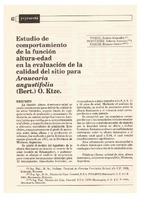Estudio de comportamiento de la función altura-edad en la evaluación de la calidad del sitio para Araucaria angustifolia (Bert.) O. Ktze.
Study of dominant height/age function in site quality evaluation for Araucaria angustifolia (Bert.) O. Ktze.
Date
1991-09-01Author
Friedl, Ramón Alejandro
Fernández, Roberto Antonio
Crechi, Ernesto Héctor
Metadata
Show full item recordAbstract
La función altura dominante-edad es usada comúnmente para definir la calidad de los sitios forestales, aspecto básico de cualquier estudio de producción y crecimiento. No obstante, no existen comprobaciones en América Latina que verifiquen su comportamiento a tal efecto, y en particular en lo que concierne a diferentes densidades de plantación. Esto último, conjuntamente con el grado de asociación entre dicha altura y la producción en volumen, fue evaluado a partir de datos de un ensayo plantado en 1971, en la Provincia de Misiones, Argentina.
Se ajustó el modelo del logaritmo de la altura dominante en función al inverso de la edad (modelo de Schumacher), y posteriormente se efectuó el análisis de covariancia para comparar las ecuaciones obtenidas para 10 tratamientos (densidades iniciales), correspondientes a datos tomados a los 6, 8, 9, 11 y 19 años de edad. Mediante el análisis de correlación, se evaluó la asociación entre la altura dominante y el volumen total correspondiente a cada parcela.
Se comprobó que las ecuaciones correspondientes a las densidades iniciales estudiadas no diferían estadísticamente, de manera que la densidad inicial no afecta a dichas funciones. En tanto se obtuvo un coeficiente de correlación entre la altura dominante y el volumen total igual a 0,94, el cual resultó estadísticamente significativo. Esta información permite recomendar a la altura dominante como una variable adecuada para la evaluación de la calidad de sitio. The dominant height/age function is normally used to define the quality of forest sites, a basic aspect for any study involving production and growth.
Nevertheless, there is no proof in Latin America to verify that the function is valid for site evaluation, particularly regarding different plantation densities.
The function behavior regarding different plantation densities, together with the degree of association between dominant height and volume production was evaluated from data of an essay installed in 1971, in the Province of Misiones, Argentina.
The logarithm of dominant height versus the reciprocal of age model (Schumacher’s model) was adjusted, and an analysis of covariance was made, to compare the resulting equations of 10 (ten) treatments, corresponding to data obtained at 6, 8, 9, 11 and 19 year of age.
Correlation analysis served to evaluate the association between dominant height and total volume of each plot.
The results indicate that there are not statistical differences between the equations corresponding to initial densities. Therefore, the initial densities didn’t have affect over those equations.
The correlation coefficient between dominant height and total volume was of 0.94 that is statistically significant.
Those results permit to recommend the use of the variable dominant height in forest site quality evaluation.
Collections
- Revista Yvyraretá [360]
The following license files are associated with this item:




